

 |
 |
 |
 |
 |
 |
WHAT'S GOING ON
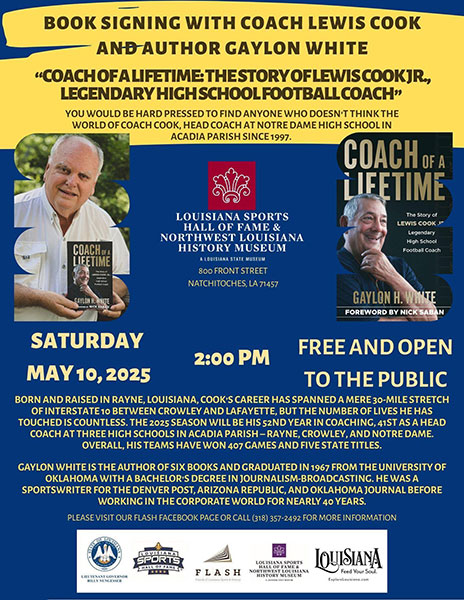
Coach Louie Cook Featured in New Podcast
A podcast featuring Coach Louie Cook of Notre Dame High School in Acadia Parish and author Gaylon White has been added to the power-packed lineup of The Real Voices of the Game Podcast Network.
Based on White's book, "Coach of a Lifetime: The Story of Lewis Cook Jr, Legendary High School Football Coach," the podcast will dive deeper into the dozens of tales in the book plus topical subjects in sports such as athletes playing multiple sports versus specializing in one.
Established in May 2022 by Dave Dagostino of Myrtle Beach, SC, The Voices of the Game Podcast Network has aired 707 episodes of 18 podcasts that can be heard every week by 103,000 subscribers in 100 countries. The podcasts can be downloaded free on Apple, Amazon, Spotify, Stitcher and iHeart.
The Cook-White show will be co-hosted and produced by Dagostino, a former pro baseball player and college baseball and basketball coach.
Other Voices of the Game podcasts headline Jim Katt, a Hall of Fame pitcher and television sports commentator; Jeff Frye, a second baseman in the majors for nine years; Kevin Kernan, a Hall of Fame baseball writer; Bob Schaefer, special assistant to the general manager of the Washington Nationals; Mark Wiley, former director of pitching operations for the Colorado Rockies; Jerry Trupiano, long-time radio voice of the Boston Red Sox; and Joe Frisaro, a former traveling secretary in major league baseball.
"It's a varied and entertaining group of people with life experiences that inform and inspire," Dagostino said. "Coach Cook overflows with wisdom about football and life and White has a way of bringing it out in stories that leave a lasting impression."
Many of Coach Cook's fans have submitted photos with the book.
Look at all those happy faces!
IN THE SPOTLIGHT
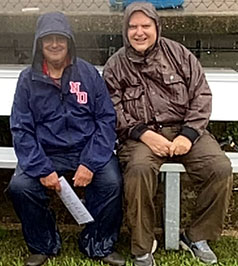
Notre Dame nipped Southside 21-20 in its rain-drenched season opener Sept. 6 at
Gardiner Memorial Stadium in Crowley, LA
There's almost always a story behind each story in a book.
Sometimes a story gets condensed, combined with other stories, or left out completely for some reason.
October Sky
Orlando Thomas
Mayberry & Sunglasses
Underdogs
The story of Michael Goss Jr., a backup wide receiver for Notre Dame High School in 2021, is mentioned in Coach of a Lifetime but not in the detail that it's told by author Gaylon White in a vignette titled, The Spelling Bee Champ.
Spelling Bee Champ
_JJF-4546-8percent.jpg)
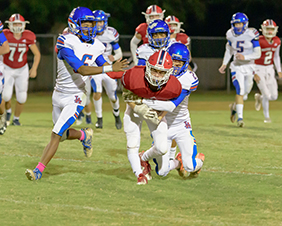
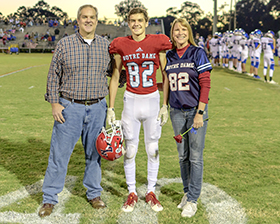
Michael Goss Jr, a three-time participant in the Scripps National Spelling Bee
in Washington, D.C., is tackled down after catching his only pass as a member of the Notre Dame High
varsity squad. Michael is shown with his father, Michael Sr., and mother, DeAnn.
- Photos courtesy of Jason Faul
Behind the Front Cover
By Rory White
Rory White is an accomplished photographer who specializes in capturing compelling images of musicians, architects, artists, and businesspeople. He lives in Kingsport, Tennessee. For more information go to www.rorywhite.com
Photographing for a book cover requires a service mindset. One should imagine traveling through time and space to where a hardworking designer is making the most from limited resources, trying to create a compelling cover design with a title that can survive being reduced to the size of a digital thumbnail image. What is more important: art or data? The answer is both. I knew that the greatest service that I could provide to the publisher, Rowman and Littlefield, is to not have to choose between the two.
Coach Cook only had a very short time to be photographed. For the sake of time, we had to choose between shooting on-location versus in-studio. The studio offers greater security against foul weather, transportation issues, and other unforeseeable complications. The use of a stadium location, however, would have been ideal as a setting for a figure like Coach Cook. To broaden the options for what kind of story the book cover might tell, I planned to create both a studio and a location solution with only a studio shoot.
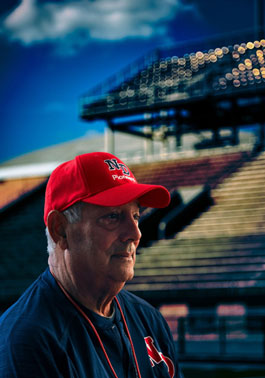
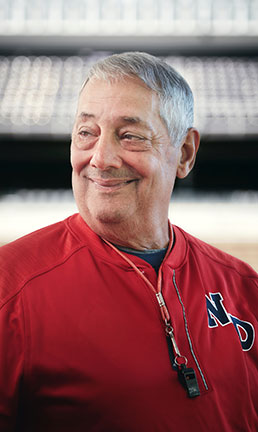
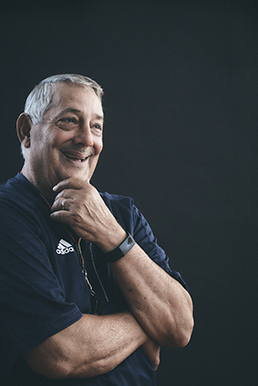
It does not appear realistic if there is a severe disparity between the lighting of a subject and its background. Therefore, the art direction had to acquiesce to factors that were most 'undirectable'. A stadium does not easily move or "pose" and is lit either by sun or stadium lights. We didn't have the budget or cooperation of the stadium to control the lights, so finding the best time for the sun to illuminate the stadium was our starting point. The most available and accessible stadium in town faced south, allowing for the bleachers to be evenly illuminated from sunrise to sundown. Once they were photographed (without Coach Cook), I noted the location of the sun and incorporated that information into how Coach should be lit during his studio appearance. I planned to shoot studio portraits of Coach on a simple background, and then utilize the stadium images as background "plates" that would merge aesthetically with the studio lighting. This provided choices for the publisher to create a simple cover image (without a busy set) or to populate the cover image with more context (bleachers, scoreboards, grassy field, etc.)
As a final effort to provide image content for the book, we set up a few apple boxes for the coach to stand on as if he was climbing stairs that led into the stadium center. He posed with a stance facing away from the camera and was set in an image taken from underneath the bleacher entrance. I imagined that this would tell the story of a triumphant retirement and allude to the theme of "entering into the light". Again, the lighting in the studio was designed to simulate the light that enters in from the end of a dark tunnel.
The final selected image reminds me that it requires very little content to fill a cover space, and the adage "less is more" often holds true. Coach smiled at a comment that had just been made in the studio, and the lights fired, I knew that the cover had been captured. All other images taken after that were simply insurance. Coach's sincere joy of life radiantly beamed clearly for a moment and fortunately we have the proof not only captured in-camera, but also on book covers worldwide.
Remembering the Bombing of Hiroshima
Adapted from the book, Handsome Ransom Jackson: Accidental Big Leaguer,
by Ransom Jackson Jr. with Gaylon H. White
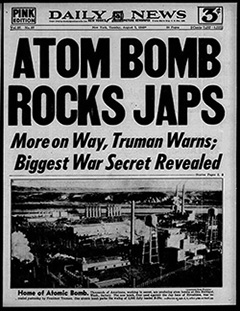
New York's Daily News
August 7, 1945
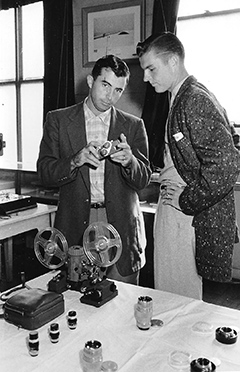
Ransom Jackson and Don Drysdale
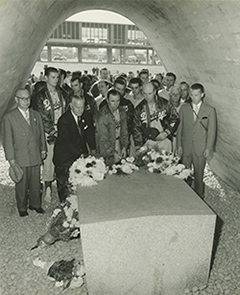
Dodgers at Hiroshima memorial honoring those killed by the atomic bomb dropped on the city
August 6, 1945.*
The New York Yankees beat the Brooklyn Dodgers in the 1956 World Series, but it was the Dodgers who were treated like kings in a month-long tour of Japan.
Everywhere we went there were "Welcome B Dodgers" signs and parades with confetti and balloons flying around us in the back seats of the convertibles we rode in. On arriving in Tokyo, some 100,000 onlookers lined the streets in a light, drizzling rain to cheer our twenty-six-car motorcade as it traveled from Haneda airport to the Imperial Hotel downtown.
From Tokyo we went to Sapporo, Sendai, Mito, Kofu, Utsunomiya, Fukuoka, Shimonoseki, Hiroshima, Osaka, Gifu, Nagoya and Shizuoka before returning to Tokyo and Fukuoka. Altogether, we visited thirteen cities. Except for Tokyo and Hiroshima, they were places most of us never heard of, let alone pronounce.
We played nineteen games in front of more than 450,000 fans, an average of around 24,000 per game. That topped the 15,761 the Dodgers averaged at home in 1956 and slightly below Milwaukee's major-league high of 26,576.
The Dodgers' goodwill tour was the third by a big-league team since World War II ended in 1945. The New York Giants visited in 1953 followed by the Yankees in 1955.
The day after losing the seventh game of the World Series to the Yankees, we boarded a chartered Pan American DC7 aircraft at New York City's Idlewild Airport to fly to Honolulu, Hawaii, for three exhibition games and, then, on to Tokyo with an eight-hour stopover on Wake Island to fix a couple of flat tires. "If there is anything we can do to make your flight more pleasant, let us know," a flight attendant announced as we started the journey. "By the way, my name is Miss Larsen."1
We wanted to forget the perfect game the Yankees' Don Larsen pitched against us and the Japanese fans helped us do that. They loved baseball and they knew all about the Brooklyn Dodgers and Jackie Robinson, Duke Snider, and Sal Maglie, some of our big stars. They were disappointed Maglie stayed home but not for long as a kid pitcher named Don Drysdale wowed them with his physical size and devastating fastball.
At six-foot-six, Don already was "Big D" on the mound. He threw sidearm, kind of herky-jerky, and the ball sank toward right-handed batters, sometimes breaking their bats. He was intimidating and beginning to show the dominance that enabled him to win 209 games in the majors.
Don's won-loss record was 5-5 in 1956, his first in the big leagues. A twenty-year-old left-hander, Sandy Koufax, was 2-4. They were both wild. When they pitched batting practice, I skipped it and found something else to do. I could tell they had a great future because they made me doubt my own. Hall of Famer Orlando Cepeda best described Don: "The trick against Drysdale is to hit him before he hits you."2
We lost two of the first three games, the most losses by any big league club on a Japanese tour. The Yankees were 15-0-1 and the Giants 14-1-1. We finished with a 14-4-1 record. "It would not be an overstatement to say that we no longer have anything to learn from the Dodgers," the former manager of one Japanese team said.3
"The Dodgers looked on the trip as a holiday," explained Vin Scully, long-time radio voice of the Dodgers. "But the Japanese looked on it as a crusade, and they played to win."4
The Japanese teams had something to prove. They were made up primarily of all-stars from the country's two professional leagues. I was impressed with their speed and how much ground they covered on defense. The one big weakness was a dearth of power hitters but they made up for that by spraying hits all over the field.
In Osaka, veteran American umpire Jocko Conlan tried stopping the game after six innings because of darkness and a light drizzle. Nearly 40,000 fans protested with chants of "Yaro!" - Play ball! The game continued with the Dodgers scoring seven runs in the eighth to win 14-7.
In Tokyo, a pitcher for the Yomiuri Giants ignored his manager's decision to intentionally walk Jackie with a runner on second and the game tied 4-4 in the eleventh inning. Jackie doubled in the winning run.
In Shimonoseki, Gino Cimoli hit a line-drive shot up the middle that careened off the pitcher's head into right field corner for a triple. We were shocked that the pitcher wasn't knocked down and out by the blow. He was removed from the game but, as all Japanese pitchers did, he threw about fifteen pitches in front of the dugout before continuing to the locker room.
We spent two nights on trains sleeping in beds so small that Drysdale had to lie on his side with his legs pulled up high in a fetal position. It was a sight that would've endeared him even more to his new fan club of young Japanese girls. In Sapporo the hotel where we stayed didn't have enough rooms so some of the players slept on the floor.
On one flight the plane was about to touch down when, suddenly, it shot up and to the left before circling and landing safely. When we got off the plane, one of the American servicemen at the airport told us we were lucky because the plane was about to crash into the terminal before it veered away. Emotions were high as we arrived in Hiroshima late one afternoon for a game the next day.
On August 6, 1945, Hiroshima was reduced to a virtual wasteland by the world's first atom bomb dropped from an American B-29 bomber, the Enola Gay. The blast killed 140,000 people. Approximately two-thirds of Hiroshima's 90,000 buildings were destroyed.
Eleven years had passed and thousands of the buildings replaced. The ballpark was new. But there was no replacing the people who lost their lives. For those who survived, there was no forgetting.
The players were told not to go out alone at night. If we left the hotel, it should be in pairs or threesomes. Drysdale and I roomed together in Japan. We stayed in the lobby of the hotel where we talked with a receptionist and bellman that were in their early twenties. "Where were you when the bomb was dropped?" I asked.
They said a couple of weeks before the bombing American planes dropped leaflets in the area telling residents to go to the nearby mountains for safety because something terrible was going to happen.
"Our families took it very seriously," one of them said. "We went up in the mountains along with a lot of other people. We lived through the blast and that's why we're here today."
I mentioned the story in a speech in Georgia many years later and a man came up to me afterwards with tears in his eyes. "I was a gunner on one of the planes that dropped the leaflets," he said. "Keep telling that story."
Recently, the news media has challenged the leaflets story, claiming they were dropped after Hiroshima was bombed. The young people who credited the warning leaflets with saving their lives and the man in Georgia had no reason to make up the story so I'll always believe them.
The morning of the game in Hiroshima Dodger executives and players visited a memorial to the bombing victims and dedicated a bronze plaque near the entrance to Hiroshima Stadium. Inscribed on the plaque are these words: "We dedicate this visit in memory of those baseball fans and others who here died by atomic action on August 6, 1945. May their souls rest in peace and with God's help and man's resolution peace will prevail forever, amen."5
The Japanese people gave us the royal treatment, but they were the real kings in Japan. They rebuilt their cities, transformed their country and created a lasting peace. Today, Japanese baseball is respected worldwide and consistently produces major-league stars. And Japanese baseball fans are as passionate today as they were in 1956.
NOTES
1Sport magazine, April 1957, 26-27.
2National Baseball Hall of Fame: http://baseballhall.org/hof/drysdale-don
3The Pantagraph (Bloomington, IL), October 23, 1956, 13.
4Sport magazine, April 1957, 92.
5Sporting News, November 21, 1956, 7.
*Photos courtesy of Ransom Jackson Jr.
©2025 GaylonWhite.com